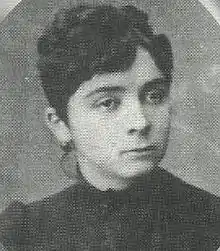Agustina Andrade
Agustina Pastora Andrade (9 August 1858 – 10 February 1891) was an Argentine poet, considered to be one of the principal writers of the Generation of '80,[1] and "probably the most praised female poet of the 1870s".[2] The daughter of the poet Olegario Victor Andrade, her poems were praised by Martín Coronado for their "idealized romantic love".

Early life and work
Agustina Andrade was born in Gualeguaychú, Entre Ríos on 9 August 1858 (or 1861)[3] in the town of Gualeguaychú, in the province of Entre Ríos. She was the daughter of the poet Olegario Victor Andrade and Maria Eloisa Quiñones González. Interested in poetry from a young age, she began to publish her work by 16. With her father and the young Leandro N. Alem, Andrade worked on Álbum poético argentino, released in 1877.[4] Encouraged by her father, she began publishing her poems in La Tribuna, forming a distinct poetic style, clearly influenced by Victor Hugo and Gustavo Adolfo Bécquer. In 1878, she published the volume Lágrimas, and the following year authored Flor de un día.[5] Her poems were praised by the likes of Benigno Tejeiro Martínez and Martín Coronado for their "idealized romantic love". In his Poesías (1877), the poet Gervasio Méndez includes the poem, ¿Cuándo vuelves á tu patria? A mi simpática amiga Agustina Andrade (When will you return to your country? To my good friend, Agustina Andrade).[6] Andrade's poem La Fé was described as a "revelation".[7]
Personal life
Andrade met the military officer Ramón Lista (1856–1897), when he arrived to explore southern Argentina. In 1879, they married in Buenos Aires. Lista left the Territorio Nacional de Santa Cruz, where he became the second governor, while Andrade lived in Témperley, about twenty kilometers from the city of Buenos Aires. Although they did not see much of each other, the couple had two daughters. In 1890, Andrade learned that her husband maintained a parallel family in Patagonia with an indigenous Tehuelche woman called Koila, with whom he had a daughter.[8] Heartbroken, she locked herself in the house for months on end, before leaving her two daughters in the care of her mother and committing suicide with a revolver on 10 February 1891.[9] She is buried in the La Recoleta Cemetery in Buenos Aires.
See also
References
- Secuencia (in Spanish). Instituto Mora. 2007. p. 148.
- Frederick, Bonnie (1998). Wily Modesty: Argentine Women Writers, 1860–1910. Arizona State University, Center for Latin American Studies Press. p. 50. ISBN 978-0-87918-086-7.
- LaGreca, Nancy (2009). Rewriting Womanhood: Feminism, Subjectivity, and the Angel of the House in the Latin American Novel, 1887–1903. Penn State Press. pp. 17–. ISBN 978-0-271-03438-6.
- Cutolo, Vicente Osvaldo (1971). Nuevo diccionario biográfico argentino, 1750–1930 (in Spanish). Vol. 1. Ed. Elche. p. 165.
- Rosso, Lorenzo J. (September 1929). La Literatura argentina: Revista bibliográfica (in Spanish). Talleres gráficos argentinos L. J. Rosso. p. 256.
- Méndez, Gervasio (1877). Poesías. La Tribuna. pp. 49–.
- Cané, Miguel (1885). Charlas literarias (in Spanish) (Public domain ed.). Charaire. pp. 50–.
- Sosa, Norma (1 January 2001). Mujeres Indígenas: De la Pampa y la Patagonia (in Spanish). Emecé Editores. p. 162. ISBN 978-950-04-2283-3.
- Chiesa, Alicia Mercedes; Andrade, Agustina (1 January 1998). Agustina Andrade: Vida y Obra Poética (in Spanish). Editoríal Confluencia. p. 6. ISBN 978-987-96710-4-7.